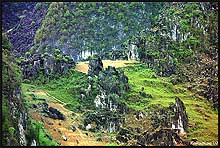Stone plateau may be declared world geological park
Update: Sep 15, 2009
Government officials and experts in the northern province of Ha Giang are working on documents for submission to UNESCO for recognising Dong Van Stone Plateau as a world geological park.
 Dong Van, which has remained untouched for hundreds of millions of years, has mammoth rocks spread over four districts – Quan Ba, Yen Minh, Meo Vac, and Dong Van – and is 1,000m above sea level. Dong Van, which has remained untouched for hundreds of millions of years, has mammoth rocks spread over four districts – Quan Ba, Yen Minh, Meo Vac, and Dong Van – and is 1,000m above sea level.
The natural heritage site, expected to become the first geological park in Vietnam next year, has been surveyed by Vietnamese scientists and specialists from Russia, Poland, Japan, Belgium, and Germany.
They have found 40 heritage areas with valuable evidence about the Earth’s evolution, rock formations, caves, valleys and other features.
The plateau is made up of at least 80% limestone and has fossils of thousands of species of ancient creatures from 400-600 million years ago.
It is also home to several cultures that sprung up over the centuries. The 574m² plateau now has 250,000 people belonging to 17 ethnic groups.
The park, expected to provide geologists a glimpse into the Earth’s past, will also boost tourism, and help eliminate poverty in the area.
At a two-day seminar attended by Vietnamese and foreign geologists in the province last weekend, Hoang Minh Nhat, the province’s Party Committee Secretary, called on the international community to help preserve and develop the Dong Van Plateau.
He added that since a geological park is still a new concept in Vietnam, it requires the support of other international geological parks.
The Belgian, Malaysia, and Italian ambassadors in Vietnam, also attending the meeting, hailed the area’s natural beauty and culture.
Nhat said: "The mysterious rock highland is waiting for local and foreign experts to study it. The site will be preserved".
Pham Sanh Chau, General Secretary of UNESCO Vietnam, expects Dong Van to get UNESCO recognition at a conference in Malaysia next April.
It will be only the second geological park in Southeast Asia after Langkawi Geological Park in Malaysia and the 54th in the world.
VNS
|
 |
|